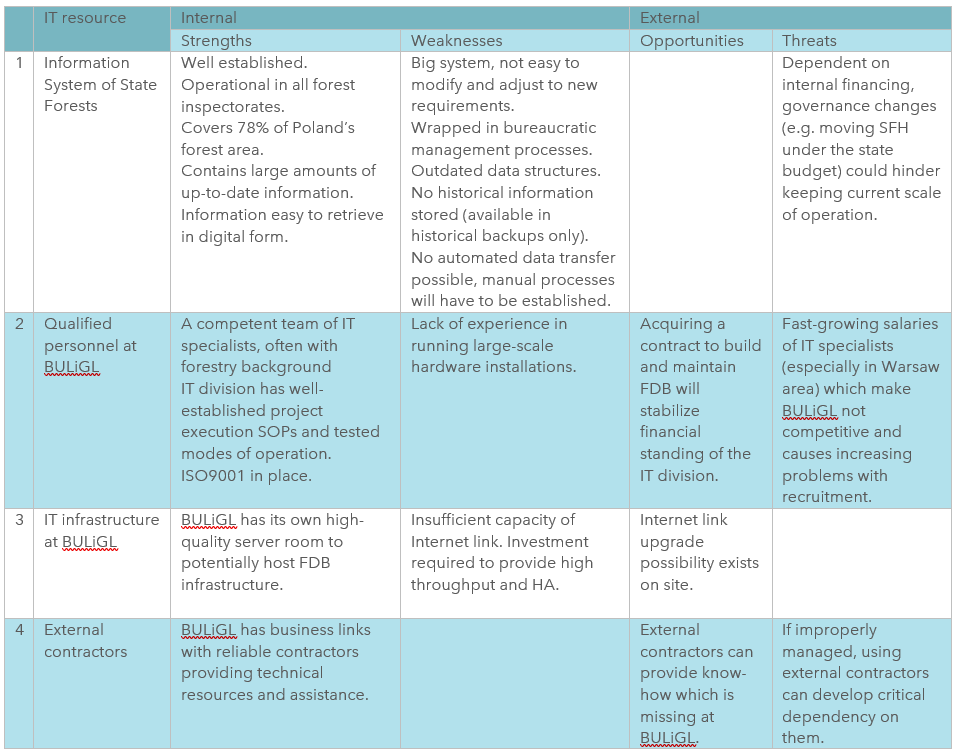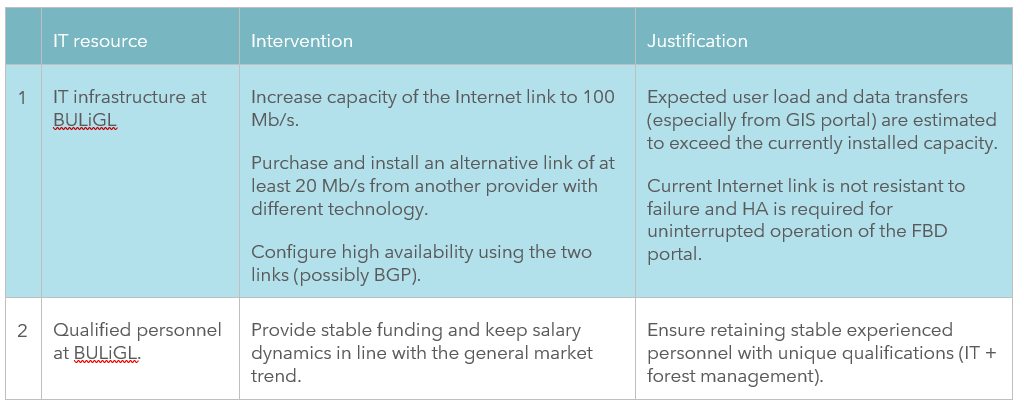Phase 2: Analysis of performance and capacity
Assess available and required IT resources
Objective of the exercise
The objective of the exercise is to conduct a Strengths, Weaknesses, Opportunities, and Threats (SWOT) analysis of the available and required critical IT resources in the forestry sector's information processing domain to facilitate effective strategic project planning aligned with business goals.
Introduction
To effectively plan strategic projects leading to improvements defined in the business goals, it is necessary to identify how and where information technologies are employed (processes) and what resources (see the next chapter) currently exist in relation to information processing in the forestry sector. It is part of the effort to evaluate the performance and capacity of IT to meet the IT objectives defined in previous exercises.
The approach used is a SWOT analysis of each resource assessed and considered important for the process of FIS development.
The following types of IT resources should be included in the analysis:
- existing IT systems;
- qualified personnel;
- communication infrastructure;
- servers and other backend infrastructure;
- software-as-a-service (SaaS) solutions available; and
- available IT services.
Existing IT systems
Existing IT systems includes all the software applications and hardware infrastructure that the forestry sector currently uses to process and manage information. It may involve data management systems, inventory tracking software, analytics tools, GIS (Geographic Information System), and more. These systems are critical as they form the backbone of information processing and decision-making within the organization.
Qualified personnel
Qualified personnel refers to the skilled and knowledgeable workforce responsible for managing, maintaining, and utilizing the IT resources. Having qualified personnel is crucial to ensure the smooth functioning of IT systems, troubleshoot issues and optimize processes to derive valuable insights from the data.
Communication infrastructure
Communication infrastructure encompasses the network and communication channels that enable data transfer and collaboration. It includes local area networks (LANs), wide area networks (WANs), internet connectivity and other communication protocols. A robust communication infrastructure is vital for seamless data-sharing and real-time collaboration, especially in geographically dispersed forestry operations.
Servers and backend infrastructure
Servers and backend infrastructure are the physical or virtual servers that store and process data, along with the supporting infrastructure like data centres, storage systems and cloud platforms. Reliable servers and backend infrastructure are critical for data storage, processing, and retrieval, ensuring data accessibility and security.
Software-as-a-Service solutions at disposal
Software-as-a-Service (SaaS) solutions are cloud-based software applications provided by third-party vendors. They offer flexibility and scalability without the need for extensive on-premises infrastructure. SaaS solutions used in the forestry sector might include data analytics platforms, project management tools and other specialized applications.
Available IT services
Available IT services refers to outsourced or managed services that the forestry sector can leverage, such as IT consulting, cybersecurity services, data analytics services and software development services. These services can supplement internal capabilities and expertise.
What are the steps in assessing available and required critical information technology resources?
The steps in the assessing available and required critical information technology resources are as follows:
- SWOT analysis; and
- Evaluation and identification of points of intervention.
Step 1. SWOT analysis
The SWOT analysis will be performed using a simple template shown in figure below (already filled in with example information). It is important that participants have knowledge of the current situation regarding IT resources within the area of analysis (e.g. country, forest agency, forest enterprise) and a general understanding of what these resources are and what is their general purpose.
Each resource is recorded in a table and is assessed over two dimensions: internal and external factors. For each dimension, both positive and negative aspects should be identified.

Practical note: The moderator presents a large table (on paper on the wall or on a whiteboard). Participants first insert the name of IT resource in the table rows. Once all important IT resources have been identified, participants assess each resource.
Care should be taken to distinguish internal and external factors. While this could be complex, users tend to understand the difference better over time. As a rule of thumb, anything that is a property of the resource should be considered internal, while all factors outside the resource location influences or organizations will be treated as external.
Step 2. Evaluation and identification of points of intervention
The completion of the SWOT table should be followed by the identification of the crucial resources which require intervention to reach (or keep) the level sufficient from the point of view of FIS development, i.e their condition, service level, quality, quantity, etc.. There is no standardized routine for this, as it largely depends on local conditions and priorities. Figure below contains points of intervention identified as crucial for building the Forest Data Bank in Poland.

It might turn out that some required interventions are so extensive and/or costly that this may jeopardize the viability of the entire FIS project. This would be important information for decision-makers to know at this point, as they might decide to re-evaluate their priorities and develop other solutions.